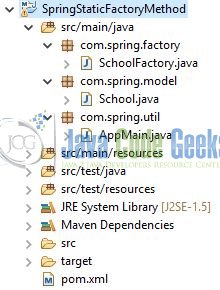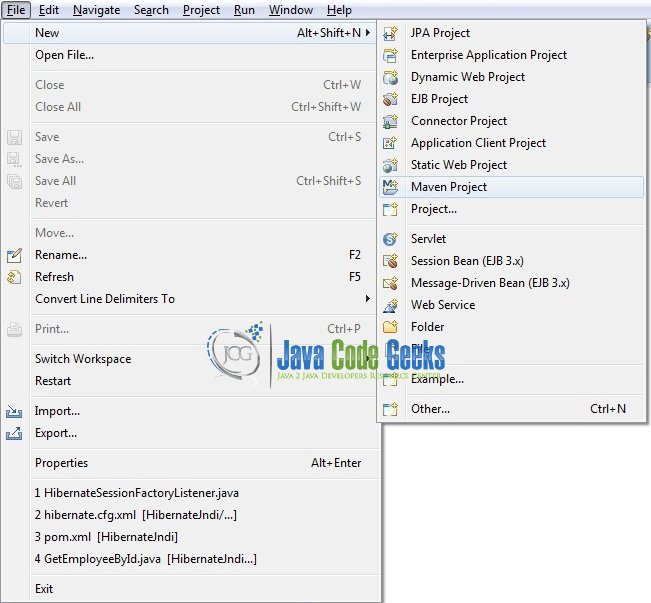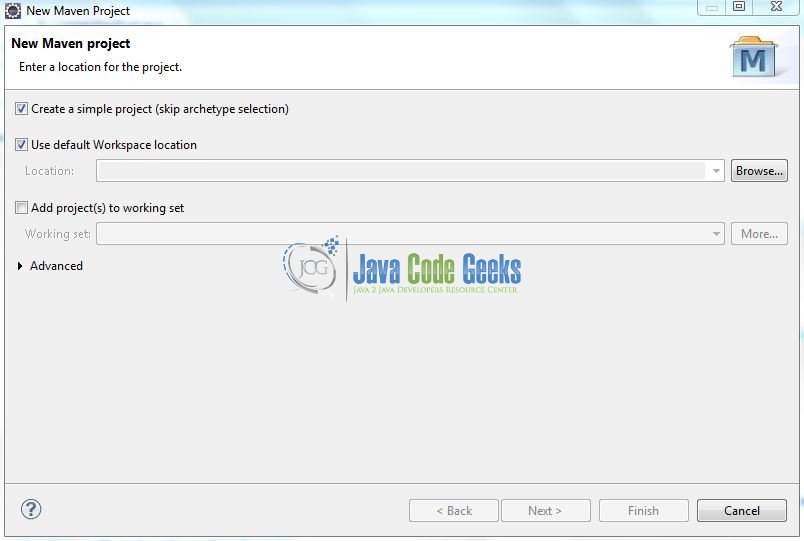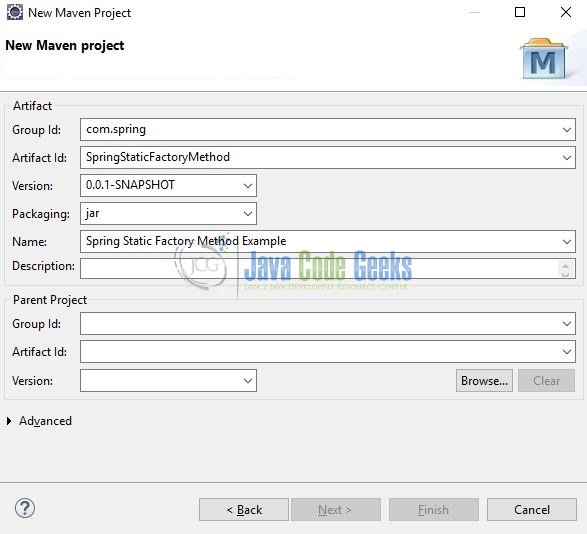Spring static factory-method Example
In spring, developers can create a bean (or the object instantiation) by invoking the static-factory-method. This tutorial will explore the use of factory-method attribute in the spring configuration file.
- The
factory-methodattribute is used when the factory-method is static in nature
1. Introduction
- Spring is an open-source framework created to address the complexity of an enterprise application development
- One of the chief advantages of the Spring framework is its layered architecture, which allows the developer to be selective about which of its components they can use while providing a cohesive framework for
J2EEapplication development - Spring framework provides support and integration to various technologies for e.g.:
- Support for Transaction Management
- Support for interaction with the different databases
- Integration with the Object Relationship frameworks for e.g. Hibernate, iBatis etc
- Support for Dependency Injection which means all the required dependencies will be resolved with the help of containers
- Support for
RESTstyle web-services
Now, open up the Eclipse IDE and let us see how to implement this attribute in the spring framework!
2. Spring static factory-method Example
Here is a systematic guide for implementing this tutorial in the spring framework.
2.1 Tools Used
We are using Eclipse Kepler SR2, JDK 8 and Maven. Having said that, we have tested the code against JDK 1.7 and it works well.
2.2 Project Structure
Firstly, let us review the final project structure, in case you are confused about where you should create the corresponding files or folder later!

2.3 Project Creation
This section will demonstrate how to create a Java-based Maven project with Eclipse. In Eclipse IDE, go to File -> New -> Maven Project.

In the New Maven Project window, it will ask you to select a project location. By default, ‘Use default workspace location’ will be selected. Select the ‘Create a simple project (skip archetype selection)’ checkbox and just click on the next button to proceed.
It will ask you to ‘Enter the group and the artifact id for the project’. We will input the details as shown in the below image. The version number will be by default: 0.0.1-SNAPSHOT.
Click on Finish and the creation of a maven project is completed. If you observe, it has downloaded the maven dependencies and a pom.xml file will be created. It will have the following code:
pom.xml
<project xmlns="http://maven.apache.org/POM/4.0.0" xmlns:xsi="http://www.w3.org/2001/XMLSchema-instance" xsi:schemaLocation="http://maven.apache.org/POM/4.0.0 http://maven.apache.org/xsd/maven-4.0.0.xsd"> <modelVersion>4.0.0</modelVersion> <groupId>com.spring</groupId> <artifactId>SpringStaticFactoryMethod</artifactId> <version>0.0.1-SNAPSHOT</version> <packaging>jar</packaging> </project>
We can start adding the dependencies that developers want like Spring Core, Spring Context etc. Let us start building the application!
3. Application Building
Below are the steps involved in developing this application.
3.1 Maven Dependencies
Here, we specify the dependencies for the spring framework. Maven will automatically resolve the rest dependencies such as Spring Beans, Spring Core etc. The updated file will have the following code:
pom.xml
<project xmlns="http://maven.apache.org/POM/4.0.0" xmlns:xsi="http://www.w3.org/2001/XMLSchema-instance"
xsi:schemaLocation="http://maven.apache.org/POM/4.0.0 http://maven.apache.org/xsd/maven-4.0.0.xsd">
<modelVersion>4.0.0</modelVersion>
<groupId>com.spring</groupId>
<artifactId>SpringStaticFactoryMethod</artifactId>
<version>0.0.1-SNAPSHOT</version>
<name>Spring Static Factory Method Example</name>
<dependencies>
<!-- https://mvnrepository.com/artifact/org.springframework/spring-beans -->
<dependency>
<groupId>org.springframework</groupId>
<artifactId>spring-beans</artifactId>
<version>5.0.8.RELEASE</version>
</dependency>
<!-- https://mvnrepository.com/artifact/org.springframework/spring-context -->
<dependency>
<groupId>org.springframework</groupId>
<artifactId>spring-context</artifactId>
<version>5.0.8.RELEASE</version>
</dependency>
</dependencies>
<build>
<finalName>${project.artifactId}</finalName>
</build>
</project>
3.2 Java Class Creation
Let us write the Java classes involved in this application.
3.2.1 Implementation of Bean class
Add the following code to the bean definition.
School.java
package com.spring.model;
public class School {
private int id;
private String name;
private String location;
public int getId() {
return id;
}
public void setId(int id) {
this.id = id;
}
public String getName() {
return name;
}
public void setName(String name) {
this.name = name;
}
public String getLocation() {
return location;
}
public void setLocation(String location) {
this.location = location;
}
@Override
public String toString() {
return "*** School Details ***\n Id= " + id +"\n " + "Name= " + name + "\n Location= " + location + "\n ";
}
}
3.2.2 Implementation of Factory class
Add the following code to the factory class.
SchoolFactory.java
package com.spring.factory;
import com.spring.model.School;
public class SchoolFactory {
public static School getSchool(String loc) {
School school = null;
if(loc.equalsIgnoreCase("Vikaspuri")) {
school = new School();
school.setId(1001);
school.setName("Oxford Senior Secondary School");
school.setLocation(loc);
} else if (loc.equalsIgnoreCase("Janakpuri")) {
school = new School();
school.setId(1002);
school.setName("Stanford Public School");
school.setLocation(loc);
} else {
throw new IllegalArgumentException("Unknown school");
}
return school;
}
}
3.2.3 Implementation of Utility Class
Add the following code to the implementation class for testing the static factory-method configuration.
AppMain.java
package com.spring.util;
import org.springframework.context.support.AbstractApplicationContext;
import org.springframework.context.support.ClassPathXmlApplicationContext;
import com.spring.model.School;
public class AppMain {
public static void main(String[] args) {
// Reading the spring configuration file!
AbstractApplicationContext ac = new ClassPathXmlApplicationContext("spring-staticfactory.xml");
School s = (School) ac.getBean("oxford");
System.out.println(s.toString());
School s1 = (School) ac.getBean("stanford");
System.out.println(s1.toString());
ac.close();
}
}
3.3 Bean Configuration file
In the spring xml configuration, we’ll use the factory-method attribute for the beans creations.
spring-staticfactory.xml
<?xml version="1.0" encoding="UTF-8"?>
<beans xmlns="http://www.springframework.org/schema/beans"
xmlns:xsi="http://www.w3.org/2001/XMLSchema-instance" xmlns:context="http://www.springframework.org/schema/context"
xsi:schemaLocation="
http://www.springframework.org/schema/beans http://www.springframework.org/schema/beans/spring-beans.xsd
http://www.springframework.org/schema/context http://www.springframework.org/schema/context/spring-context.xsd">
<bean id="oxford" class="com.spring.factory.SchoolFactory"
factory-method="getSchool">
<constructor-arg value="Vikaspuri" />
</bean>
<bean id="stanford" class="com.spring.factory.SchoolFactory"
factory-method="getSchool">
<constructor-arg value="Janakpuri" />
</bean>
</beans>
4. Run the Application
To execute the application, right click on the AppMain class, Run As -> Java Application. Developers can debug the example and see what happens after every step. Enjoy!
5. Project Demo
The code shows the following log as the output of this tutorial.
Oct 20, 2018 3:28:16 PM org.springframework.beans.factory.xml.XmlBeanDefinitionReader loadBeanDefinitions INFO: Loading XML bean definitions from class path resource [spring-staticfactory.xml] *** School Details *** Id= 1001 Name= Oxford Senior Secondary School Location= Vikaspuri *** School Details *** Id= 1002 Name= Stanford Public School Location= Janakpuri Oct 20, 2018 3:28:16 PM org.springframework.context.support.AbstractApplicationContext doClose
That is all for this tutorial and I hope the article served you whatever you were looking for. Happy Learning and do not forget to share!
6. Conclusion
This post defines the implementation of the factory-method attribute in the spring framework and helps developers understand the basic configuration required to achieve this. Developers can download the sample application as an Eclipse project in the Downloads section.
7. Download the Eclipse Project
This was an example of spring static factory-method for beginners.
You can download the full source code of this example here: SpringStaticFactoryMethod






